You are holding your chef’s knife wrong If you use a handle or a fingertip grip. That is one of the most heard phrases when we get a new apprentice at the restaurant. But are they holding the knife wrong? That is what you will find out in this article.
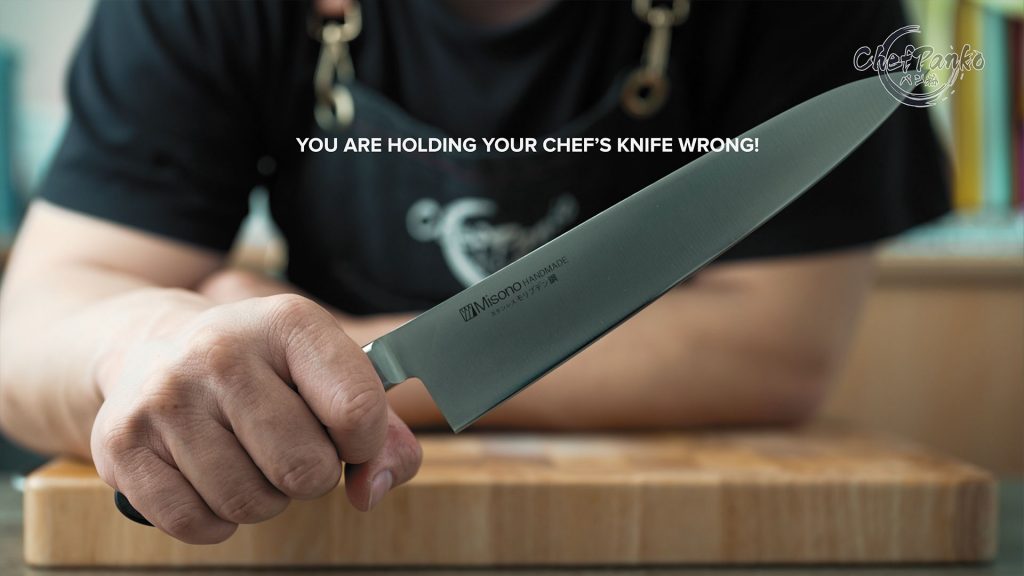
Safety First!
Before we jump into the gripping styles I want you to know that safety is your primary objective when we hold a knife. To be as safe as possible, you need a knife that is comfortable, well balanced, and will assist you with your cutting style. And in my case, it is the forward chopping motion (Pinch Grip at the blade/bolster) and slicing motion toward myself (Fingertip Grip with the index finger on the spine of the blade). You need to know why a certain gripping style is recommended over the others. But always use a claw grip when you slice or chop your food to protect your fingers when you accidentally slip with your knife.
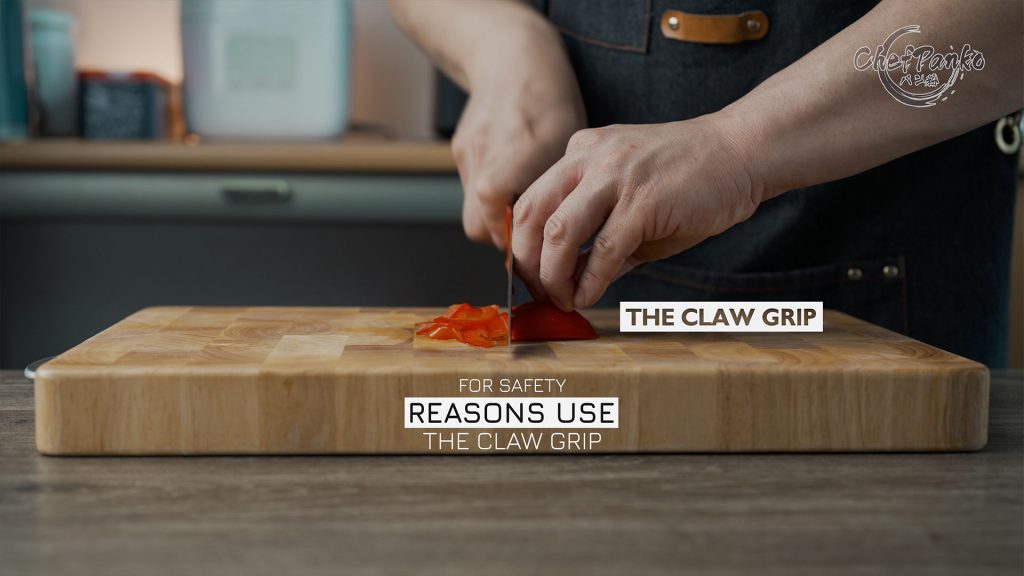
Pinch grip at the blade/bolster/cap
The pinch grip at the blade or bolster is the most recommended gripping style because you will have a more sturdy and stable control over the blade. The blade will not move in all directions and therefore you are less likely to cut yourself. The handle and the fingertip grip will give you the opposite effect. The blade will wobble left to right a lot especially if you increase your cutting speed.

The handle grip
The handle grip is not a natural position for many cooks at the restaurant. However, the home cooks will naturally hold the knife at the handle since that is the most logical for them. With the handle grip, you will have less control over your blade and if you try to cut faster the blade will move sideways.

However, most knife brands that focus on home cooks will emphasize the handle design since they cut a lot slower and use a shorter knife length to compensate for the instability during use.

Fingertip Grip
Like the handle grip, the fingertip grip is not stable since nothing supports the blade. In addition to the unstable knife, you will also strain your finger if you are going to cut a lot of dense food like potatoes or carrots.

However, a lot of sushi chefs will use the fingertip grip all the time but that is mainly to do with the cutting motion, knife style, and the type of food they are prepping which is softer and less dense.
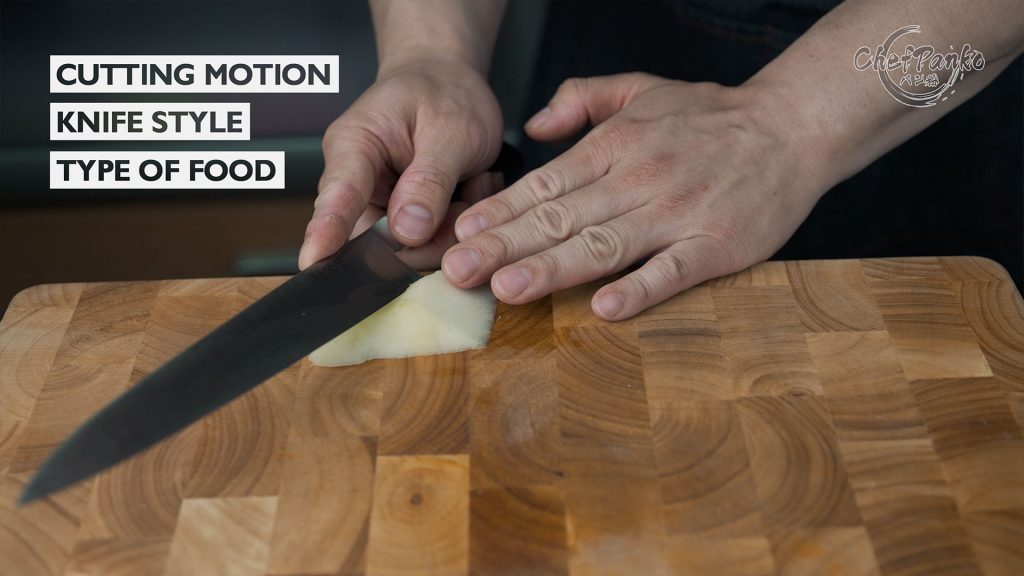
Cutting Motions
The Chef’s knife or a Gyuto is one of the most versatile knives. You can rock chop with it on things like herbs, you can rock slice on things like bell peppers, and you can trim or slice things off with the tip without feeling any drag or food sticking to the blade because of the narrower front. But with the versatility, you need to have a comfortable grip that accommodates all the slicing or chopping motion. And that is why the chefs at the restaurant recommend the pinch grip at the blade or near the bolster since it is sturdier, more stable, and therefore safer. Especially if you increase your cutting speed.
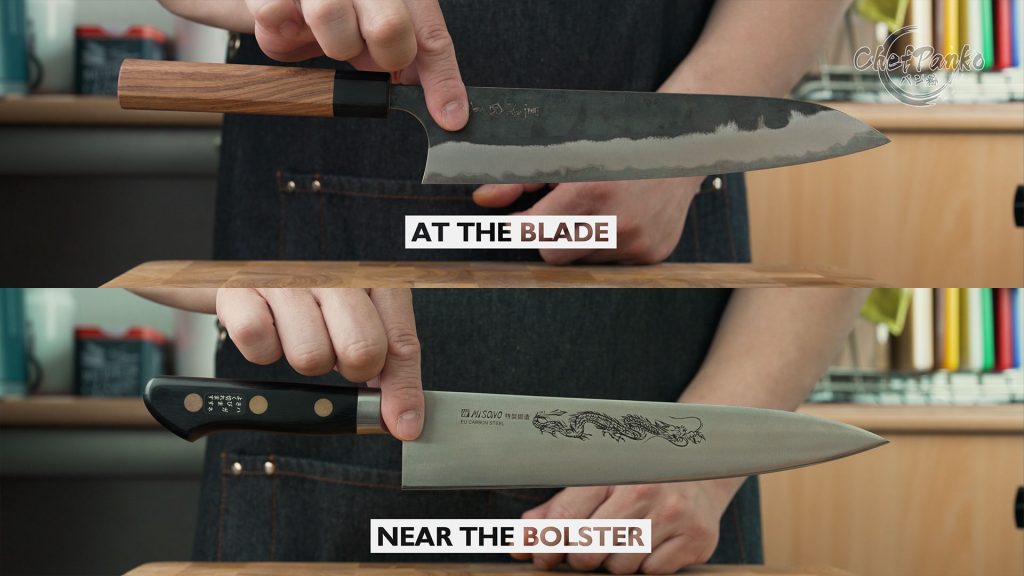
Speed & Length
The biggest problem with gripping the knife at the handle is speed. The faster you try to cut your food the less stable your blade will be. However, if you slow down your cutting speed the knife is easier to be controlled.
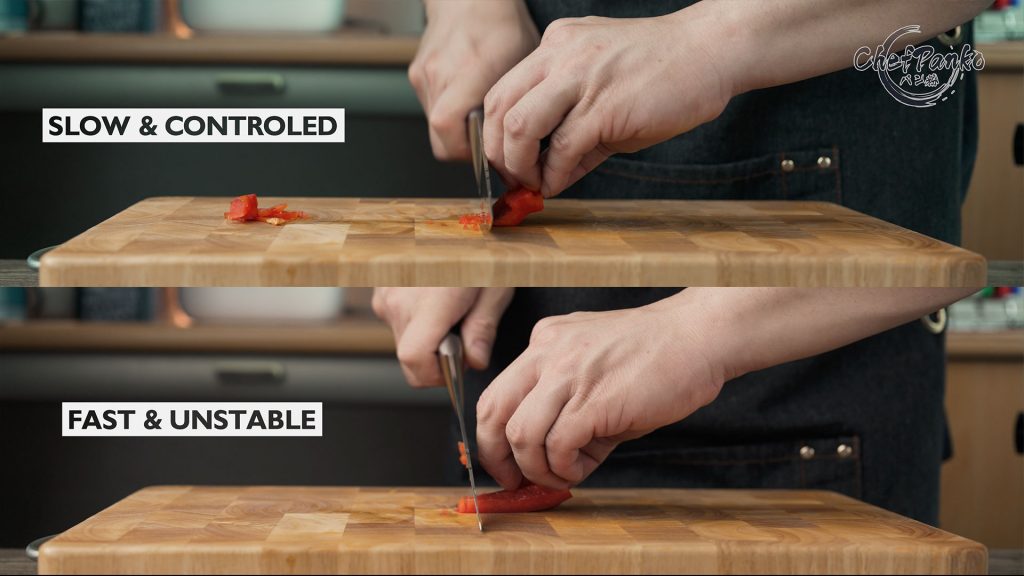
The same comes with the knife length, the longer the knife the harder it is to get more control over the blade with a handle grip.

Knife style & different grips
Of course with each knife style, comes a different gripping style. For example, a Yanagiba is mainly used to slice through softer less dense food and the main purpose is to use long strokes to slice through fish or other less dense food. A pinch grip is not going to work since there is not much to grab onto at the blade and therefore you see sushi chefs using a fingertip grip with this type of knife.


They focus more on precision and precise cut than speed.
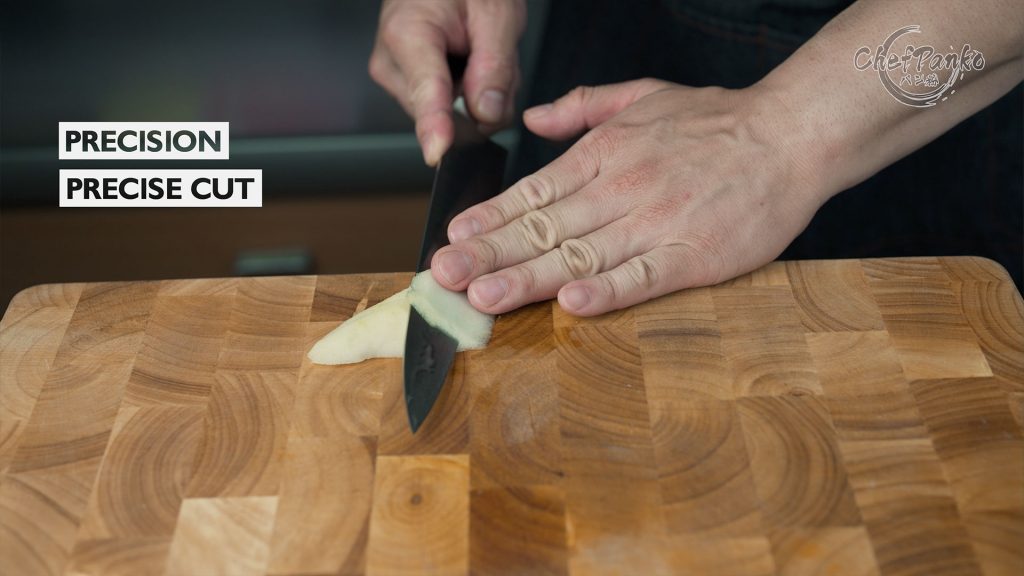
The same can be said for a petty knife which is used for delicate slicing work or on smaller produce. It is not designed for hard dense food or food that is bigger than the knife.

And a paring knife is used off the cutting board which also requires a different grip.

What grip should you use?
While I recommend the pinch grip at the blade or bolster, don’t be afraid to change the gripping style that accommodates you with your cutting task.

My primary gripping style will be a pinch grip at the blade or bolster, but I will change to a fingertip grip dependent on what I slice and what cutting motion I use. Dependent on what and how I slice, I will adjust my speed and grip accordingly.
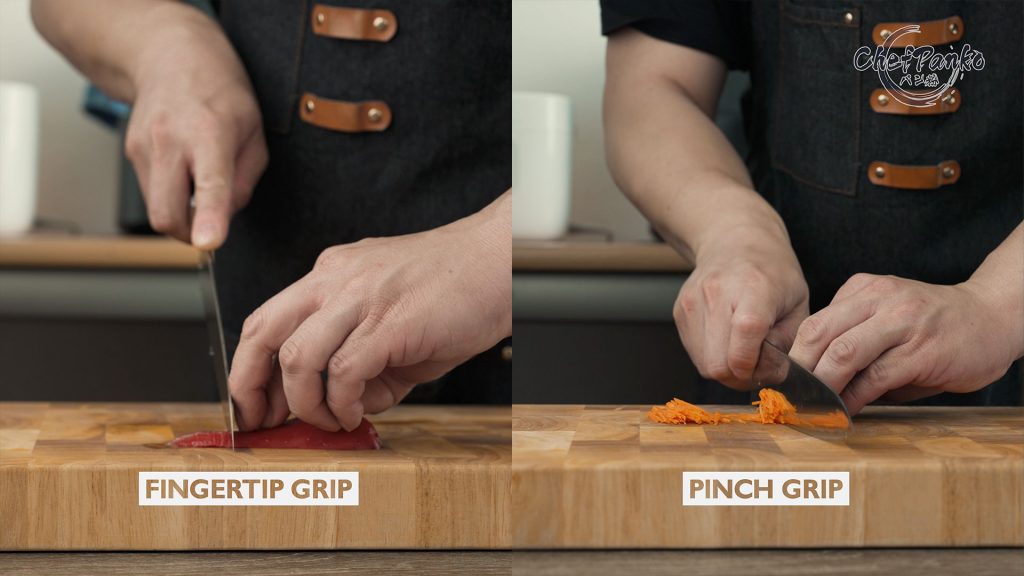
One of the reasons why I pinch a certain knife at the neck or bolster is because of the point of balance. The knife will neither be front nor handle heavy and therefore giving me total control over the blade.
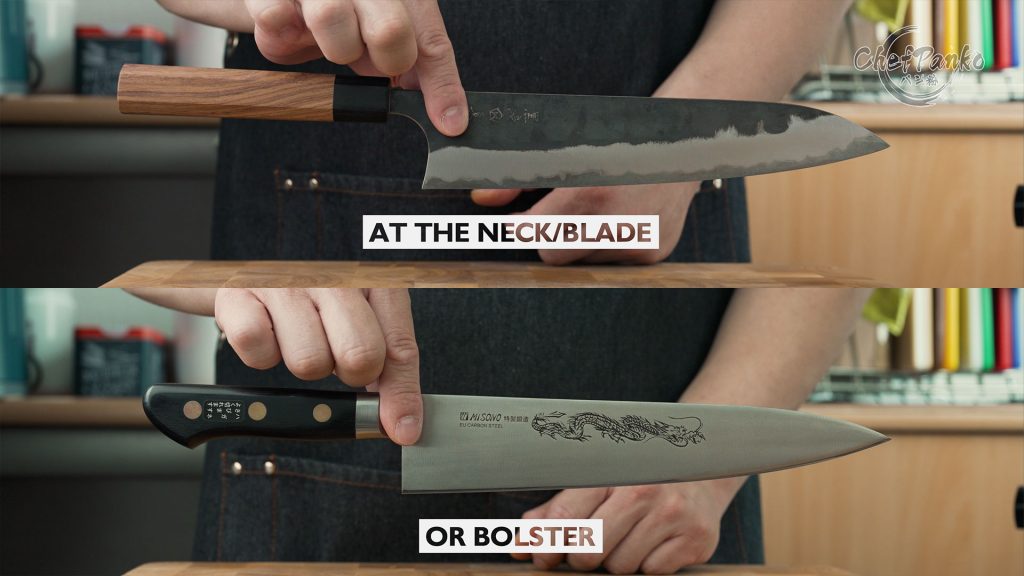
If the knife handles heavy it will resist my primary cutting motion constantly since it is not balanced for my preferred gripping point.
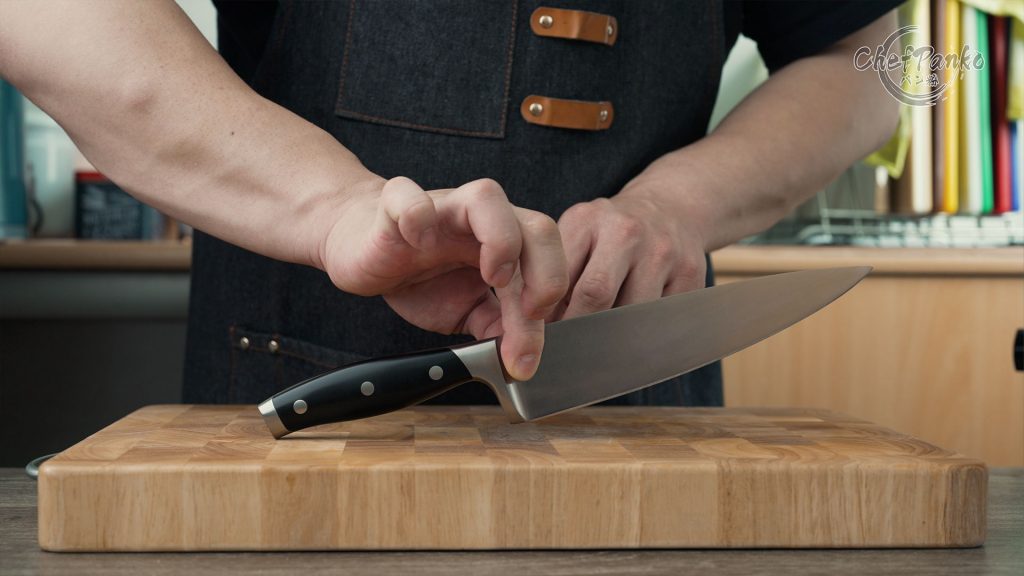
As long as you know why a certain grip is recommended, then there is no right or wrong.
Home Cooks gripping Style?
If you are a person who always used a handle grip, I suggest that you consider a few things. Do you need the speed? If you need the speed then I highly recommend a pinch grip.
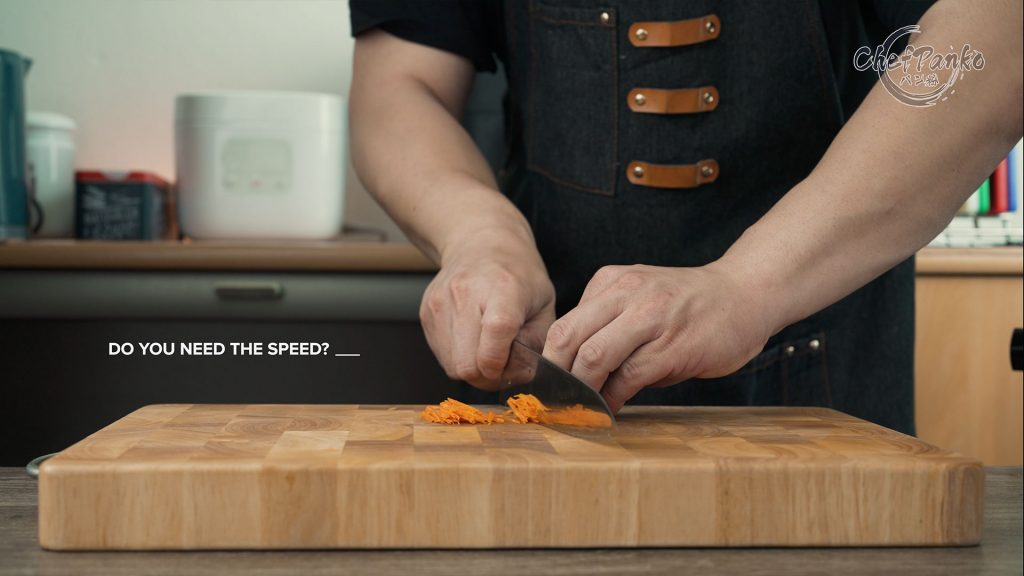
But this also means that the knife design should accommodate this kind of gripping style. Since a lot of knives that are made for home cooks are designed to accommodate a gripping style at the handle. You should do what is the most comfortable for you with your cutting motion, speed, and knife design but always keep safety in mind.
Conclusion
I hope that you understand why the pinch grip at the blade or bolster is recommended and why it is not wrong if you deviate from it as long as you understand the why.
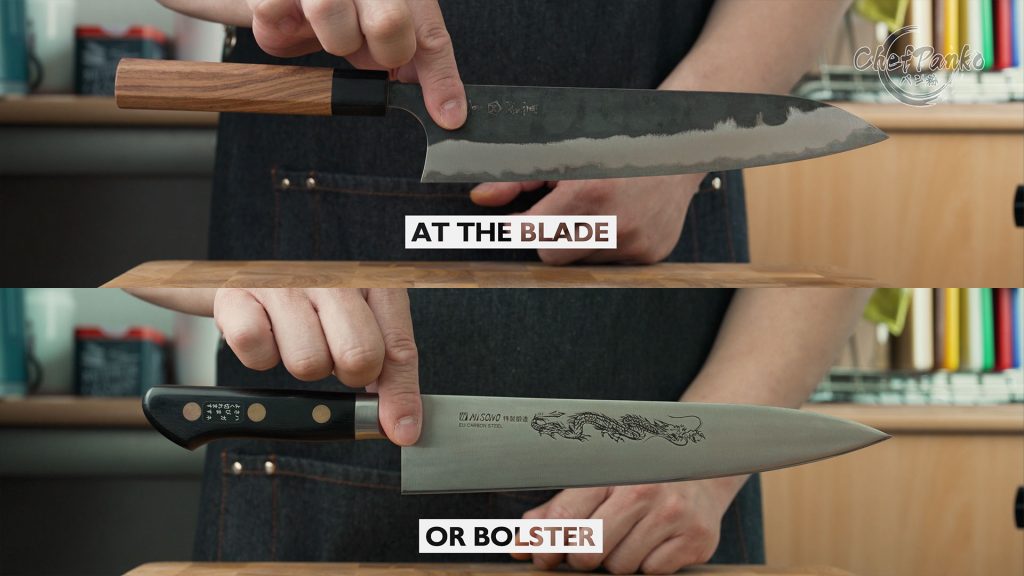
The handle grip knows many variations. You have the pinch grip at the handle, the grip with the thumb on top, the knife balancing on the index finger, and more.
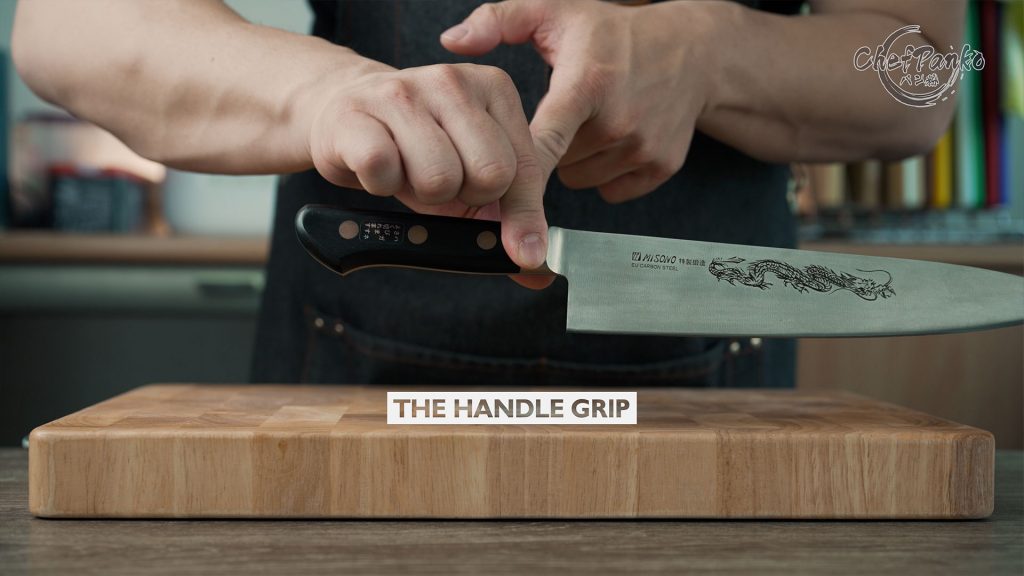

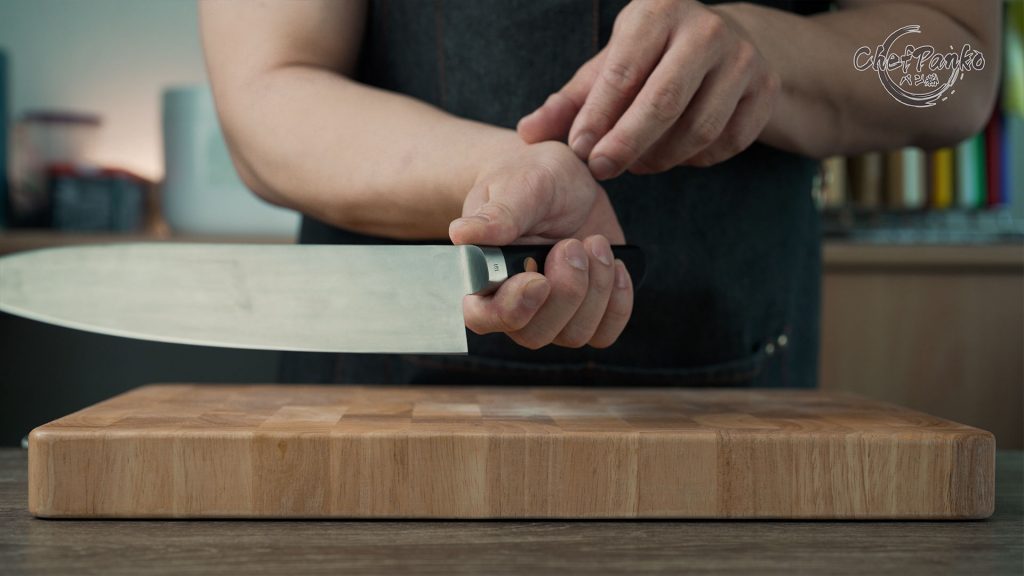

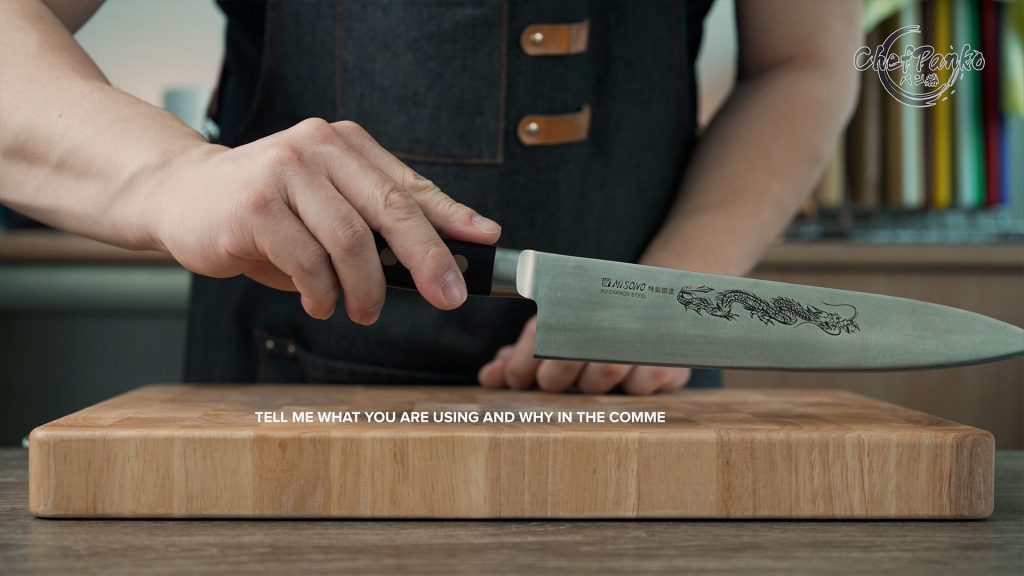
Tell me what you are using and why in the comment section and feel free to ask me any questions.
🛒S H O P:
All knives used in this article:
Japanese Made Knives:
🔪Misono Handmade Gyuto
🔪Misono 440C
🔪Misono 440C 27cm [Proffesional use]🔪Misono UX10 Petty
🔪Misono High Carbon EU Steel Gyuto
🔪Kasumi Chef’s Knife/Gyuto
🔪Kasumi Yanagiba
German Made Knife:
🔪Henckels Zwilling Pro
Swiss-Made Knife:
🔪 Victorinox Paring Knife
Western Knife Style made in China:
🔪Linoroso
🔨Japanese Blacksmith/Artisan Knife:
🔪Makoto Kurosaki, Gyuto Kurouchi – 240mm – Shirogami White #2
▶ If you want to know what knife you should buy you can read the following article ''Choosing your knife''. ▶ On my youtube channel, I have reviewed a lot of different knives. You can watch the playlist by clicking here. ▶ Click here, if you want to search for other kitchen knives on: Amazon. ▶ , if you want to search for other Chinese knives on . ▶ Check out my gear on Kit: https://kit.co/ChefPanko ▶ Check out my recommendation on Amazon: https://www.amazon.com/shop/chefpanko Full Disclosure: If you purchase from these links I get a small commission that goes towards supporting the channel and website. As an Amazon Associate, I earn from qualifying purchases ▶ If you have any questions about Japanese knives made in China or about some of the brands feel free to ask it in the comment section below. Thank you for your support and feedback. ▶ Want to work with me? Please use the contact form by clicking here.

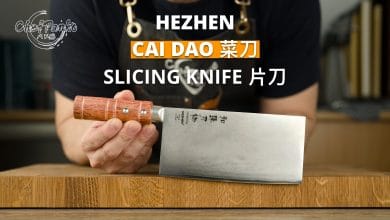
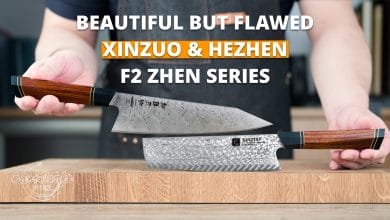
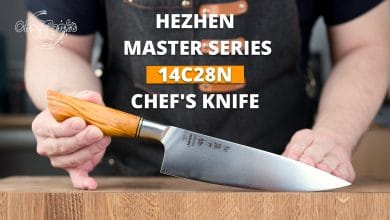
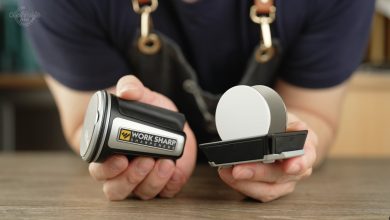
At work, I use a pinch grip while using our cutting knives (chef knives). The quality of the knives are extremely sub-par. I sharpent the knives every time I have to work. I work part time. I understand the need for a good edge. Currently, we have only 2 knives that don’t have a spoiled edge – they are used daily for cutting fruit and produce. I work in a salad bar for a grocery store. My older brother was a butcher by trade, therefore, taught me the importants of having sharp, good knives. I have excellent knives at home that I use, however, my work knives are cheap. They do not have the balance required for good cutting. My co-workers mearly “chop” the fruit i a wacking motion. I don’t do this, I cut the fruit and vegetables as you have demonstration in a pinching motion away from my body for safety. Cut gloves area always worn as well. This is a mandate of the company.
My problem is that I was put on a job where I was doing nothing but cutting for 2.5 months. During that time, I sustained injury to my right hand. I believe this is because of repetition each day as well as not having excellent tools to work with. The handle of the knife I use is too narrow for my liking. I wonder if a larger handle might be able to give me more comfort. My pain in is my wrist and thumb. I am in physiotherapy for this.
The company will not replace the knives but I am wondering if there are devices to put on a narrow handle to make it more rounded to mimic the natural curve of my hand?
Or, can you recomment knives that I can purchase myself to use at work that will be only for me to use?
Thank you and I look forward to hearing from you.
Regards,
Jane Code
Waterloo, Ontario, Canada.
I had that and many others when we started working at the restaurant. It is more from overuse, especially when you are just starting and have no experience. Since they won’t adjust the workload with proper rest for new apprentices. They however get less work to do but that has mainly to do with the fact that they are slower with prep work as they are just starting but that does not mean it is not taxing on the body.
Wrist and finger pain from overuse is quite common, and the long hours of standing especially when they directly start working full time, standing for long hours at the same position without walking is very taxing on the knees and ankles so overuse injuries on those are also quite common for starters.
As for the wacking motion, I guess that it is for a rough chop (bigger chunks of veggies/fruits), while not ideal for the knife’s edge it is faster.
I hope that you can sort it out with your physiotherapist, but your idea of thinking is good!
From, my experience and the advice I give to new apprentice cooks is to lessen the workload by making it more comfortable for yourself.
Since in most cases taking a proper rest period while you are on the working roster is not an option so lessening the workload by making it more comfortable for you is key in recovery.
As for the knife suggestion, for a rounder belly or something that contours better around your hand/fingers, it is hard to recommend a handle with a rounder belly as most of them are not good it is either too begin or just not aligned well enough. The Victorinox knife is a good option while the handle is quite big it did not feel uncomfortable and actually sits nicely in my hands I heard from others with a smaller hand size that they like the handle too (I have a large glove size). If you are in the NA, I heard the Dexter Russel or Mercer Culinary knives are good too according to my viewers never tried it myself.
But for a better recommendation your hand size might be a good factor too, since you said that the knives were too narrow the Victorinox is bigger. But a longer knife length will have a bigger/thicker/longer handle too starting from 24CM+ the handle will become bigger.
I find Japanese was-handles octagonal ones also very comfortable for my large hand size. For western handles, 8-inch 20/21cm Gyuto’s I find them a tad too small/narrow for prolonged usage so I opt for a bigger blade of 24cm since the handle will be bigger too.
As for devices that make a handle bigger not that I’m aware of so I can” give you any recommendations on that.
Victorinox/Dexter is probably a better option, as they are on the budget side. You can always ask your employer to purchase new knives as that should be in the company’s budget along with proper maintenance tools. A honing rod is good to have to upkeep the edge. (just like in the restaurant we have shared knives, honing rods, and whetstones however nobody maintains the company’s tools but that is something for your colleagues and higher-ups to make a company policy for it).
Hopefully, this can help your problems but if you can I suggest trying some knives out in a store where you can hold them as the weight of a knife can be reduced too to lessen the workload.
Other tips I can give you on proper form while doing prep work.
Twist your body to make the cutting position comfortable for you, and rotate your veggies to get a more comfortable position.
As for my video, you see me cutting straight into the camera, but this is not a proper form since it is only modified to get better footage.
In the text ”Safety First!” you can see the picture that the food and blade are directly pointing to the camera, you can see my wrist in an unnatural position.
Rotate the food and blade so that it is angled (video and pictures are done to make the point better by compensating the proper form since I’m a one-man band I can’t move the camera or stand behind it while doing the prep work in front of it).
The second thing is table/workstation height, if you are a tall person you can’t tell the company to buy you a taller workstation so widen your legs so that your shoulders and hands get lowered more. This will help against back problems vs hunching towards the front. This will avoid later problems with your neck/shoulder/back.
Don’t forget to move from time to time with your feet/legs as this will lessen the workload and add some new blood flow to your knees and ankles vs the static standing position without moving during the entire prep work.
Over time you get stronger and won’t have those pains anymore, painkillers might be an option to lessen the current pain but talk to your GP about that.
Try to make it as comfortable for you as possible a new knife is a good option but also your form during the prep work can help.
Hope that this helps a bit, I know that it can become very painful due to overuse, but over time you get stronger and it won’t be a problem anymore the first few months is the hardest but after that, you get gradually stronger.
As for Physiotherapist, you can ask him for some rehab training once the pain is lessened and you can do the rehab pain-free.
As I have injured my wrist currently but due to some accident and not overuse, I have been doing some rehab exercises 3 times a week for 3 months now.
I reckon that those exercises would work too for you, but ask your Physiotherapist about it as my rehab is catered to my injury and your physio will be able to make a proper rehab program based on your problems.
Feel free to ask more questions and I wish you a speedy recovery!
Tell me what gripping style you are using and why.
Here is what I use:
The Pinch grip at the neck/bolster/blade (depending on the knife ”point of balance” if it is handle heavy I will not buy that kind of knife as it does not fit my needs)
Why?:
The knives I use will have a straighter blade profile to accommodate the ”forward chopping” motion that I use the most.
The ”Point of Balance” should be exactly at the point where I pinch grip the knife since it will neither be front nor back heavy with my gripping style.
Since the knives I use are usually 24cm+ the pinch grip at the blade or bolster will help a lot with stabilizing the blade.
You will have more control and the blade will not wobble that much if you increase your cutting speed since pinching at the blade/bolster supports the blade.
Extra info:
My secondary gripping style is the fingertip grip, but this grip is not used all the time and is mainly used because of the extra range of motion and flexibility you have with the blade and wrist.
It is used on softer produce (avocado, pear, mangoes, etc), and when I don’t want the food to stick on the blade (for presentation reasons or other reasons, etc).
With the fingertip grip, the knife will be front heavy assisting me with my slicing motion towards myself.
(Usually, I will use the fingertip grip with a Yanagiba or a Petty knife depending on what I slice but when I’m too lazy to grab a specialized knife for the task the Gytuo will do just fine).